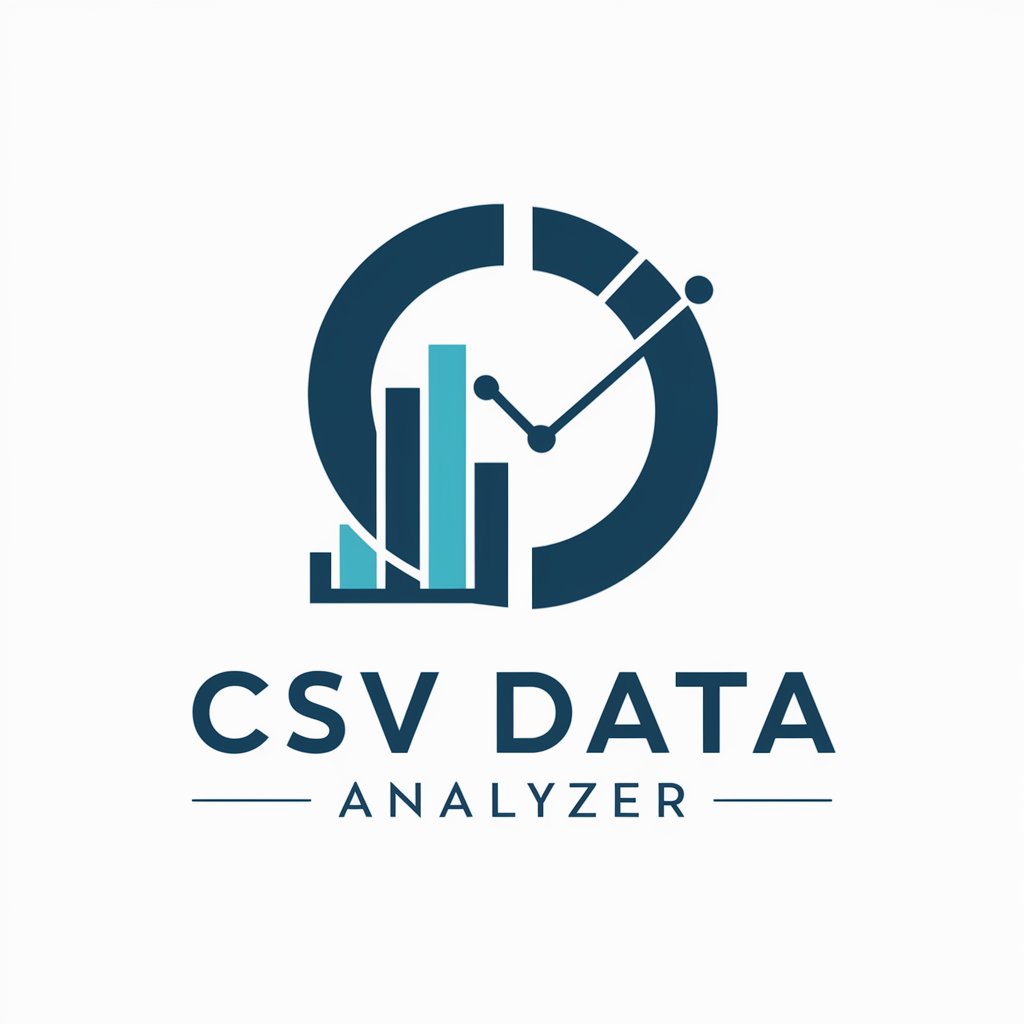
Analisis De Datos De Excel-AI Excel data analysis
AI-powered Excel analysis for faster insights

Análisis de Datos con Inteligencia Artificial ofrece apoyo especializado en la exploración de datos, abarcando desde la gestión de los mismos hasta estadísticas descriptivas, análisis inferenciales y métodos de exploración de datos.
Por favor, proporciona un conjunto de datos para su análisis.
Get Embed Code
Analisis De Datos De Excel — Purpose and Design
Analisis De Datos De Excel is an AI-augmented data analysis assistant built around spreadsheet-based workflows (Excel/CSV) and designed to accelerate practical, repeatable analysis for non-programmers and technical users alike. Its core purpose is to bridge the gap between raw spreadsheet data and actionable insights by combining: (1) automated data cleaning and transformation tailored to common Excel problems (missing values, inconsistent formats, unstandardized categorical labels, date/time parsing), (2) a suite of statistical and machine-learning analyses that are accessible from a spreadsheet context (descriptive stats, correlations, linear/logistic regression, clustering, PCA, time-series decomposition and forecasting), and (3) clear visualizations and exportable reports (charts, pivot-style summaries, presentation-ready outputs). Design choices reflect typical real-world needs: inputs remain familiar Excel files; outputs are both human-readable (interpreted results, plain-English summaries) and machine-friendly (cleaned spreadsheets, reproducible formulas, charts). The assistant prioritizes explainability: every model or test returned includes assumptions, parameter choices, and guidance on interpretation and limitations. Example scenarios: (A) a regional retailer uploads weekly sales and inventory spreadsheetsAnalisis De Datos De Excel — Analisis De Datos De Excel detects inconsistent SKUs, normalizes dates, creates a sales velocity metric, fits a simple time-series forecast per SKU, and produces a one-page dashboard with top movers and suggested reorder thresholds; (B) an academic researcher supplies a survey Excel file with partially filled responses — the assistant imputes missing values using context-appropriate methods, computes Cronbach’s alpha for scale reliability, performs PCA to reduce correlated items, and exports both a cleaned dataset and a methods summary suitable for the methods section of a paper.
Core Capabilities and Applied Use Cases
Data cleaning & transformation (ETL for spreadsheets)
Example
Receive an Excel workbook containing 12 inconsistent date formats, numeric fields stored as text, duplicated customer IDs with slight typos, and multiple country name variations ('U.S.', 'United States', 'USA'); automatically standardize dates to ISO (YYYY-MM-DD), coerce numeric columns, deduplicate using configurable fuzzy matching thresholds, and map country name variants to a canonical list.
Scenario
A mid-sized e-commerce company consolidates order exports from multiple marketplaces. Analisis De Datos De Excel ingests these sheets, normalizes column headers and formats, merges them into a canonical orders table with consistent datetime and currency formats, flags problematic rows for manual review, and produces a cleaned master file ready for sales analysis and inventory reconciliation.
Statistical analysis & modeling (descriptive through predictive)
Example
Compute descriptive statistics and distributions, produce correlation matrices with significance testing, run a multivariate linear regression predicting monthly revenue from marketing spend, season, and average order value, and perform a churn classification with logistic regression including model coefficients, AUC, confusion matrix, and calibration plot with plain-English interpretation.
Scenario
A telecom operator wants to reduce churn. The company provides subscriber records and usage metrics in Excel. Analisis De Datos De Excel prepares features (tenure buckets, usage patterns), explores correlations, trains and evaluates a churn model, outputs a score column to the original spreadsheet, and lists top 10 actionable drivers (e.g., 'low data use in months 3–4' or 'recent service tickets') so retention teams can design targeted offers.
Visualization, dashboards & report generation
Example
Generate interactive chart sets and static exports: trend-line and seasonally-adjusted time series, cohort retention tables, heatmaps of conversion by channel and device, and geo-choropleth maps by state. Export options include a cleaned Excel workbook with new sheets, a printable PDF one-page executive summary, and a slide deck containing the main charts and recommended next steps.
Scenario
A hospital quality team needs weekly KPI reporting (wait times, readmission rates, patient satisfaction). Analisis De Datos De Excel takes raw unit-level logs, computes rolling averages and control limits, creates annotated charts highlighting out-of-range units, and generates a slide deck for the leadership meeting with suggested interventions and data sources for follow-up.
Target Users and Why They Benefit
Business analysts, operations managers, and spreadsheet power users
These users routinely work with Excel but may lack time or advanced coding skills to perform repeatable, robust analyses. They benefit from rapid cleaning, standardized transformation, and built-in analytics that plug directly into their existing workflows. Examples: revenue analysts who need monthly reconciliation, operations managers building reorder rules from point-of-sale exports, or marketing analysts creating attribution reports. The assistant reduces manual cleanup time, enforces repeatable steps, and produces shareable dashboards and exportable cleaned files.
Data scientists, researchers, and analysts who need fast prototyping and reproducible Excel outputs
These technically skilled users use Analisis De Datos De Excel as a productivity layer: it accelerates routine preprocessing, automates exploratory data analysis (EDA), and produces cleaned datasets and interpretable model summaries ready for deeper modeling in Python/R or for stakeholder distribution. Use cases include academic researchers preparing datasets for statistical tests, data scientists validating assumptions and feature engineering ideas before building production pipelines, and policy analysts producing reproducible Excel appendices for reports.
How to use Analisis De Datos De Excel
Visit aichatonline.org for a free trial without login, also no need for ChatGPT Plus.
Open the site to try Analisis De Datos De Excel instantly — no account, no ChatGPT Plus required. This gives you immediate access to the tool’s demo and core features.
Prepare your Excel file
Ensure your workbook uses clear headers, consistent data types in each column, and a single table per sheet when possible. Remove unnecessary merged cells, add a date column if needed, and save as .xlsx or .csv.
Upload and select analysis
Upload your cleaned file via the tool’s upload interface, choose the sheet or range to analyze, then pick the desired analysis type (summary stats, data cleaning, correlation, regression, PCA, forecasting, visualizations).
Review, refine, and export
Inspect automatic data-cleaning suggestions, review exploratory charts and model diagnostics, tweak parameters (filters, target variable, date ranges), then export cleaned data and visuals in Excel, CSV,How to use Excel analysis or image formats.
Iterate and apply insights
Use the generated findings and visualizations to inform decisions. Try additional analyses suggested by the tool (e.g., segmentation, hypothesis tests), schedule regular re-runs for fresh data, and integrate outputs into reports or dashboards.
Try other advanced and practical GPTs
Kali Linux Pro Guide
AI-powered guide for Kali Linux workflows

Joshua - UFO Disclosure Ai
AI-powered drafting and research for disclosure

Naruto RPG isekai Adventure
AI-Powered Ninja Adventure in Isekai Worlds

英语地道口语转译/优化助手
AI-powered English fluency enhancer.

Reescrever Jurídico
AI-driven legal text rephrasing at speed.

유키짱 - 일본어회화 알려주는 일본인 여자친구
AI-powered Japanese conversation girlfriend tutor

UI/UX Design Portfolio Builder
Design your UI/UX portfolio with AI

Deep Reinforcement Learning
AI-powered DRL: train adaptive agents faster

Neo4j Cypher Wizard
AI-powered Cypher query generator for Neo4j

Scene Prompt Creator
AI-powered creator of realistic scene prompts

Toastmaster International - Public Speaking Coach
AI-driven Coaching for Confident Public Speaking

Quiz Master
AI-powered quiz creation made easy

- Visualization
- Data Cleaning
- Forecasting
- Regression
- PCA Analysis
Common questions about Analisis De Datos De Excel
What file types and sizes are supported?
Analisis De Datos De Excel accepts .xlsx and .csv files. For large datasets, the tool recommends splitting very large workbooks (>100MB or >1M rows) into smaller files or sampling; performance and available analyses scale with file size and the plan you use.
How does the automated data cleaning work?
The tool detects and flags issues such as missing values, inconsistent formats, outliers, and duplicate rows. It proposes fixes (imputation, type coercion, deduplication) with an explanation for each change. You always review and accept changes before export so nothing is altered without your consent.
Which statistical analyses and visualizations can it perform?
Core features include descriptive statistics, correlation matrices, linear and logistic regression, ANOVA, principal component analysis (PCA), time-series decomposition and forecasting, clustering, and interactive charts (histograms, scatter plots, boxplots, heatmaps). Each analysis includes assumptions, diagnostics, and plain-language interpretation.
How is my data privacy handled?
Uploaded files are processed in secure environments; the tool provides options to anonymize or remove personally identifiable fields before processing. Temporary copies used for computation are deleted after your session or per retention settings. Always check the current privacy policy for precise retention and security details.
Can I export results and integrate them with other tools?
Yes — cleaned datasets and analysis outputs can be exported as .xlsx, .csv, PNG/SVG charts, or PDF summaries. The tool also offers copy-paste-ready code snippets (Python/R) for reproducibility and simple connectors for common BI tools or cloud storage to automate downstream workflows.






